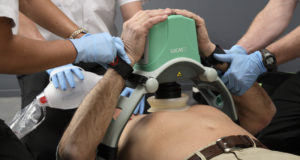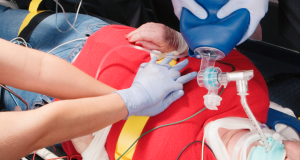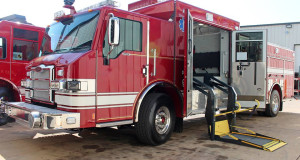On January 1, 2014, a little-read portion of the Affordable Care Act will be implemented in Medicare’s CMS bureau, the agency charged with reimbursing ambulance providers for the vast majority of their transports. In order to reflect the changes in medicine demanded by patient-advocacy organizations such as the American Nursing Association, the National Federation of Nurses and the American Medical Association; Medicare has implemented new rules to allow them to more accurately differentiate between the level of care provided versus what is billed.
 “We’ve been cut by a third by the sequester, and we don’t anticipate restaffing those positions as long as Congress is at a deadlock, so we asked for and received authorization to update our payment criteria to more efficiently review and process claims” reported Marilyn Tavenner, the head of Medicare’s CMS. “On average, it takes each staff member about ten minutes to process a report, which includes determining the level of service provided, determining what pay bracket and percentage the ticket is requesting and whether the service was actually provided. For instance, the average “ALS-1” call consists mostly of placing a cardiac monitor and an IV and billing it as an “advanced” call- but absent a pressing medical reason, we’re not going to be paying those, and reading through all of those charts takes time with all of those different levels of EMT. So, as one of our adaptations, we are going to standardize the Medicare reporting on all charts to either ‘Paramedic’ or ‘Certified Paramedic Assistant’, instead of “Emergency Medical Technician”. This is going to very easily let our evaluators determine whether the intervention was performed by a professional for a valid medical reason or if it was performed as part of a protocol that may or may not aid the patient by a vocational employee using the same criteria that we currently use for analyzing emergency departments and hospitals. Currently, the system is set to register doctors, nurses, paramedics and aides- we just don’t have the money to program in all the EMT variations and levels. A simple ‘paramedic’ will let the same analyst that screens a hospital handle that patient’s ambulance ticket too, and save us nearly eighty million dollars a year that we don’t have in our budget. After all, we don’t pay nursing homes what we pay hospitals for the work of vocational CNAs- why should ambulances be different?”
“We’ve been cut by a third by the sequester, and we don’t anticipate restaffing those positions as long as Congress is at a deadlock, so we asked for and received authorization to update our payment criteria to more efficiently review and process claims” reported Marilyn Tavenner, the head of Medicare’s CMS. “On average, it takes each staff member about ten minutes to process a report, which includes determining the level of service provided, determining what pay bracket and percentage the ticket is requesting and whether the service was actually provided. For instance, the average “ALS-1” call consists mostly of placing a cardiac monitor and an IV and billing it as an “advanced” call- but absent a pressing medical reason, we’re not going to be paying those, and reading through all of those charts takes time with all of those different levels of EMT. So, as one of our adaptations, we are going to standardize the Medicare reporting on all charts to either ‘Paramedic’ or ‘Certified Paramedic Assistant’, instead of “Emergency Medical Technician”. This is going to very easily let our evaluators determine whether the intervention was performed by a professional for a valid medical reason or if it was performed as part of a protocol that may or may not aid the patient by a vocational employee using the same criteria that we currently use for analyzing emergency departments and hospitals. Currently, the system is set to register doctors, nurses, paramedics and aides- we just don’t have the money to program in all the EMT variations and levels. A simple ‘paramedic’ will let the same analyst that screens a hospital handle that patient’s ambulance ticket too, and save us nearly eighty million dollars a year that we don’t have in our budget. After all, we don’t pay nursing homes what we pay hospitals for the work of vocational CNAs- why should ambulances be different?”
Tavenner also told reporters that EMS services could expect to see dramatic changes in reimbursement for basic services. “The fraud we’ve had over the last few years is astounding. We have hundreds of millions of dollars stolen just this year, and hundreds of millions more paid out on questionable claims. We can’t trust our vocational EMTs to accurately apply medical interventions like oxygen, spinal immobilization or use the litter appropriately, and without the staff to review the majority of our claims in detail, we are going to have to rely on individual services to staff paramedics. CNAs cannot work without a supervising nurse, the CPAs will have the same criteria.” She went on to clarify that basic services would be reimbursed at the rate of a wheelchair-van service. “The level of care is essentially the same- I think that the American people expect a paramedic to respond to their emergencies, and we feel that that is a valid expectation. You don’t see CNAs staffing an emergency room alone, do you?”
CMS’s plan is nothing new- Medicare reimbursements have shaped the EMS industry for decades- but this is first time that the pursers have exercised their power in this way. Chief George Day, a suburban Virginia fire captain, was appalled at the plan- “it sounds like I’m going to be forced to call myself a ‘CPA’, no better than the nurses’ aides”- but he may not have a choice. 2014’s CMS reimbursements for EMT services constitute 40% of his department’s budget. It’s not all negative though. Across town, the CEO of Life-star Ambulance Service was cautiously optimistic. “We’re going to hire ten new paramedics to convert our service to an all-ALS service, with a paramedic in charge of every patient encounter. We’ve already been able to secure a local transfer contract now that we’re going to have the financial backing of Medicare’s 911 reimbursements, and we’re going to be able to offer that same standard of care to our community on 911 contracts. We’re expecting quite a bit more income from those too- every run is going to benefit from the presence of a paramedic.”
Tavenner promised that the majority of the change would essentially be semantics, but she did caution that Medicare would look poorly upon services that tried to pass off EMTs as paramedics. “There’s nothing wrong with a CPA providing care, but it needs to be under the direct supervision of a paramedic. “For a CPA to pass themselves off as a paramedic is as wrong as a CNA passing herself off as a nurse, and will be treated the same way by regulating authorities.” Training for EMTs will consist of a mandatory twelve-hour interactive web-based session with emphasis on assisting paramedics with performing patient care.
“In ten years, we are going to have a paramedic responding to every emergency, and that paramedic is going to have a well-trained, standardized team of CPAs helping them.” Tavenner promised an enthusiastic crowd. “The ambulance drivers will still be there, but we’re going to have the same great care that our nurses and doctors provide in the back- and we are going to pay far more appropriately for that service.”
 Call the Cops The 27th Most Trusted Site in Public Safety
Call the Cops The 27th Most Trusted Site in Public Safety





